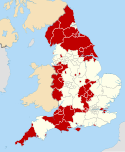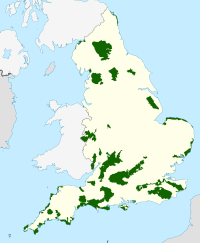Cornwall
Cornwall
Kernow(Cornish) | |
|---|---|
 Cornwall shown within England | |
| Coordinates:50°24′N4°54′W/ 50.400°N 4.900°W | |
| Sovereign state | United Kingdom |
| Constituent country | England |
| Region | South West England |
| Established | Ancient |
| Time zone | UTC+0(GMT) |
| • Summer (DST) | UTC+1(BST) |
| UK Parliament | 6 MPs |
| Police | Devon and Cornwall Police |
| Ceremonial county | |
| Lord Lieutenant | Edward Bolitho |
| High Sheriff | Stamford Timothy John Galsworthy (2024-25)[1] |
| Area | 3,562 km2(1,375 sq mi) |
| • Rank | 12th of 48 |
| Population (2022)[2] | 577,694 |
| • Rank | 40th of 48 |
| Density | 162/km2(420/sq mi) |
| Ethnicity | |
| Unitary authority | |
| Council | Cornwall Council |
| Control | Conservative |
| Admin HQ | Lys Kernow,Truro |
| Area | 3,545 km2(1,369 sq mi) |
| • Rank | 4th of 296 |
| Population (2022)[4] | 575,413 |
| • Rank | 5th of 296 |
| Density | 162/km2(420/sq mi) |
| ISO 3166-2 | GB-CON |
| GSS code | E06000052 |
| ITL | TLK30 |
| Website | cornwall |
| Districts | |
 Districts of Cornwall | |
| Districts |
|
Cornwall(/ˈkɔːrnwɔːl,-wəl/;[5]Cornish:Kernow;Cornish pronunciation:[ˈkɛrnɔʊ];or[ˈkɛrnɔ][6]) is aceremonial countyinSouth West England.[7]It is recognised by Cornish and Celtic political groups as one of theCeltic nations,and is the homeland of theCornish people.The county is bordered by theAtlantic Oceanto the north and west,Devonto the east, and theEnglish Channelto the south. The largest urban area in the county is aconurbationthat includes the former mining towns ofRedruthandCamborne,and thecounty townis the city ofTruro.
The county is rural, with an area of 1,375 square miles (3,562 km2) and population of 568,210. Outside of the Redruth-Camborne conurbation the largest settlements areFalmouth,Penzance,Newquay,St Austell,and Truro. Forlocal governmentpurposes most of Cornwall is aunitary authorityarea, with theIsles of Scillyhaving aunique local authority.TheCornish nationalistmovement disputes theconstitutional status of Cornwalland seeks greaterautonomywithin the United Kingdom.
Cornwall is the westernmost part of theSouth West Peninsula.Its coastline is characterised by steep cliffs and, to the south, severalrias,including those at the mouths of the riversFalandFowey.It includes the southernmost point onGreat Britain,Lizard Point,and forms a large part of theCornwall National Landscape.The national landscape also includesBodmin Moor,an upland outcrop of theCornubian batholithgranite formation. The county contains many short rivers; the longest is theTamar,which forms the border with Devon.
Cornwall had a minor Roman presence, and later formed part of the Brittonic kingdom ofDumnonia.From the 7th century, theBritonsin the South West increasingly came into conflict with the expanding Anglo-Saxon kingdom ofWessex,eventually being pushed west of the Tamar; by theNorman ConquestCornwall was administered as part of England, though it retained its own culture. The remainder of theMiddle AgesandEarly Modern Periodwere relatively settled, with Cornwall developing itstin miningindustry and becoming aduchyin 1337. During theIndustrial Revolution,the tin and copper mines were expanded and then declined, with china clay extraction becoming a major industry. Railways were built, leading to a growth of tourism in the 20th century. TheCornish languagebecameextinctas a living community language at theend of the 18th century,but is now being revived.
Name
[edit]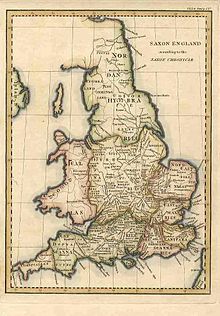

The modernEnglishname "Cornwall" is acompoundof two terms coming from two different language groups:
- "Corn-" originates from theProto-Celtic*karnu- ( "horn",presumed in reference to"headland"), and iscognatewith theEnglishword "horn" andLatin"cornu" (both deriving from theProto-Indo-European*ker-). There may also have been an Iron Age group that occupied the Cornish peninsula known as theCornovii(i.e. "people of the horn or headland" ).[8][9][10][11][a]
- "-wall" derives fromwealh,anexonyminOld Englishmeaning "foreigner", "slave" or "Brittonic-speaker" (as inWelsh).[13]
In theCornish language,Cornwall isKernowwhich stems from the sameProto-Celticroot.
History
[edit]
Prehistory, Roman and post-Roman periods
[edit]Humans reoccupiedBritainafter thelast Ice Age.The area now known as Cornwall was first inhabited in thePalaeolithicandMesolithicperiods. It continued to be occupied byNeolithicand then byBronze Agepeople.
Cornwall in the Late Bronze Ageformed part of a maritime trading-networked culture which researchers have dubbed theAtlantic Bronze Agesystem, and which extended over most of the areas of present-day Ireland, England, Wales, France, Spain, and Portugal.[14][15]
During theBritish Iron Age,Cornwall, like all of Britain (modern England, Scotland, Wales, and the Isle of Man), was inhabited by aCeltic-speakingpeople known as theBritonswith distinctive cultural relations to neighbouringBrittany.TheCommon Brittonicspoken at this time eventually developed into several distinct tongues, includingCornish,Welsh,Breton,CumbricandPictish.[16]
The first written account of Cornwall comes from the 1st-century BC Sicilian Greek historianDiodorus Siculus,supposedly quoting or paraphrasing the 4th-century BCE geographerPytheas,who had sailed to Britain:
The inhabitants of that part of Britain calledBelerion(or Land's End) from their intercourse with foreign merchants, are civilized in their manner of life. They prepare thetin,working very carefully the earth in which it is produced... Here then the merchants buy the tin from the natives and carry it over toGaul,and after traveling overland for about thirty days, they finally bring their loads on horses to the mouth of the Rhône.[17]
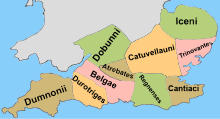
The identity of these merchants is unknown. It has been theorized that they werePhoenicians,but there is no evidence for this.[18]Professor Timothy Champion, discussing Diodorus Siculus's comments on the tin trade, states that "Diodorus never actually says that the Phoenicians sailed to Cornwall. In fact, he says quite the opposite: the production of Cornish tin was in the hands of the natives of Cornwall, and its transport to the Mediterranean was organized by local merchants, by sea and then overland through France, passing through areas well outside Phoenician control."[19]Isotopic evidence suggests that tin ingots found off the coast ofHaifa,Israel,may have been from Cornwall.[20][21]Tin, required for the production ofbronze,was a relatively rare and precious commodity in the Bronze Age – hence the interest shown in Devon and Cornwall's tin resources. (For further discussion of tin mining seethe section on the economy below.)
In the first four centuries AD, during the time ofRoman dominance in Britain,Cornwall was rather remote from the main centres of Romanization – the nearest beingIsca Dumnoniorum,modern-dayExeter.However, the Roman road system extended into Cornwall with four significant Roman sites based on forts:[22]Tregear nearNanstallonwas discovered in the early 1970s, two others were found atRestormel Castle,Lostwithiel in 2007, and a third fort nearCalstockwas also discovered early in 2007. In addition, a Roman-style villa was found atMagor Farm,Illogan in 1935.Ptolemy'sGeographike Hyphegesismentions four towns controlled by theDumnonii,[23]three of which may have been in Cornwall.[24]However, after 410 AD, Cornwall appears to have reverted to rule by Romano-Celtic chieftains of theCornoviitribe as part of the Brittonic kingdom ofDumnonia(which also included present-day Devonshire and the Scilly Isles), including the territory of oneMarcus Cunomorus,with at least one significant power base atTintagelin the early 6th century.
"King"Mark of Cornwallis a semi-historical figure known from Welsh literature, from theMatter of Britain,and, in particular, from the later Norman-Breton medieval romance ofTristan and Yseult,where he appears as a close relative ofKing Arthur,himself usually considered to be born of the Cornish people in folklore traditions derived fromGeoffrey of Monmouth's 12th-centuryHistoria Regum Britanniae.
Archaeology supports ecclesiastical, literary and legendary evidence for some relative economic stability and close cultural ties between thesub-RomanWestcountry,South Wales, Brittany, the Channel Islands, and Ireland through the fifth and sixth centuries.[25]In Cornwall, the arrival of Celtic saints such asNectan,Paul Aurelian,Petroc,Piran,Samsonand numerous others reinforced the preexisting Roman Christianity.[26]
Conflict with Wessex
[edit]TheBattle of Deorhamin 577 saw the separation ofDumnonia(and therefore Cornwall) from Wales, following which theDumnoniioften came into conflict with the expanding English kingdom ofWessex.Centwineof Wessex "drove the Britons as far as the sea" in 682, and by 690St Bonifice,then a Saxon boy, was attending an abbey in Exeter, which was in turn ruled by a Saxon abbot.[26][27]TheCarmen Rhythmicumwritten byAldhelmcontains the earliest literary reference to Cornwall as distinct from Devon. Religious tensions between the Dumnonians (who celebratedceltic Christiantraditions) and Wessex (who wereRoman Catholic) are described inAldhelm's lettertoKing Geraint.TheAnnales Cambriaereport that in AD 722 the Britons of Cornwall won a battle at"Hehil".[28]It seems likely that the enemy the Cornish fought was a West Saxon force, as evidenced by the naming ofKing Ineof Wessex and his kinsman Nonna in reference to an earlier Battle of Llongborth in 710.[29]
TheAnglo-Saxon Chroniclestated in 815 (adjusted date) "and in this year king Ecgbryht raided in Cornwall from east to west." this has been interpreted to mean a raid from the Tamar to Land's End, and the end of Cornish independence.[30]However, theAnglo-Saxon Chroniclestates that in 825 (adjusted date) a battle took place between the Wealas (Cornish) and the Defnas (men of Devon) atGafulforda.The Cornish giving battle here, and the later battle at Hingston Down, casts doubt on any claims of control Wessex had at this stage.[31]
In 838, the Cornish and their Danish allies were defeated by Egbert in theBattle of Hingston Downat Hengestesdune. In 875, the last recorded king of Cornwall,Dumgarth,is said to have drowned.[32]Around the 880s, Anglo-Saxons from Wessex had established modest land holdings in the north eastern part of Cornwall; notablyAlfred the Greatwho had acquired a few estates.[33]William of Malmesbury,writing around 1120, says that KingAthelstanof England (924–939) fixed the boundary between English and Cornish people at the east bank of theRiver Tamar.[34]While elements of William's story, like the burning ofExeter,have been cast in doubt by recent writers[31]Athelstan did re-establish a separateCornish Bishopand relations between Wessex and the Cornish elite improved from the time of his rule.
EventuallyKing Edgarwas able to issue charters the width of Cornwall, and frequently sent emissaries or visited personally as seen by his appearances in theBodmin Manumissions.
Breton–Norman period
[edit]
One interpretation of theDomesday Bookis that by this time the native Cornish landowning class had been almost completely dispossessed and replaced by English landowners, particularlyHarold Godwinsonhimself. However, theBodmin manumissionsshow that two leading Cornish figures nominally had Saxon names, but these were both glossed with native Cornish names.[35]In 1068,Brian of Brittanymay have been createdEarl of Cornwall,and naming evidence cited by medievalistEdith Ditmassuggests that many other post-Conquest landowners in Cornwall were Breton allies of the Normans, the Bretons being descended from Britons who had fled to what is todayBrittanyduring the early years of the Anglo-Saxon conquest.[36]She also proposed this period for the early composition of theTristan and Iseultcycle by poets such asBéroulfrom a pre-existing shared Brittonic oral tradition.[37]
Soon after theNorman conquestmost of the land was transferred to the new Breton–Norman aristocracy, with the lion's share going toRobert, Count of Mortain,half-brother ofKing Williamand the largest landholder in England after the king with his stronghold atTrematon Castlenear the mouth of the Tamar.[38]
Later medieval administration and society
[edit]Subsequently, however, Norman absentee landlords became replaced by a new Cornish-Norman ruling class including scholars such asRichard Rufus of Cornwall.These families eventually became the new rulers of Cornwall, typically speakingNorman French,Breton-Cornish,Latin,and eventually English, with many becoming involved in the operation of theStannary Parliamentsystem, the Earldom and eventually theDuchy of Cornwall.[39]TheCornish languagecontinued to be spoken and acquired a number of characteristics establishing its identity as a separate language fromBreton.
Stannary parliaments
[edit]Thestannary parliamentsand stannary courts were legislative and legal institutions in Cornwall and in Devon (in the Dartmoor area). The stannary courts administeredequityfor the region's tin-miners and tin mining interests, and they were also courts of record for the towns dependent on the mines. The separate and powerful government institutions available to the tin miners reflected the enormous importance of the tin industry to the English economy during the Middle Ages. Special laws for tin miners pre-date written legal codes in Britain, and ancient traditions exempted everyone connected with tin mining in Cornwall and Devon from any jurisdiction other than the stannary courts in all but the most exceptional circumstances.
Piracy and smuggling
[edit]Cornish piracy was active during the Elizabethan era on the west coast of Britain.[40]Cornwall is well known for itswreckerswho preyed on ships passing Cornwall's rocky coastline. During the 17th and 18th centuries Cornwall was a majorsmugglingarea.
Heraldry
[edit]In later times, Cornwall was known to theAnglo-Saxonsas "West Wales" to distinguish it from "North Wales" (the modern nation ofWales).[41]The name appears in theAnglo-Saxon Chroniclein 891 asOn Corn walum.In theDomesday Bookit was referred to asCornualiaand in c. 1198 asCornwal.[42][b]Other names for the county include alatinisationof the name asCornubia(first appears in a mid-9th-century deed purporting to be a copy of one dating from c. 705), and asCornugalliain 1086.
Physical geography
[edit]
Cornwall forms the tip of the south-west peninsula of the island ofGreat Britain,and is therefore exposed to the full force of theprevailing windsthat blow in from the Atlantic Ocean. The coastline is composed mainly ofresistantrocks that give rise in many places to tall cliffs. Cornwall has a border with only one other county,Devon,which is formed almost entirely by theRiver Tamar,and the remainder (to the north) by theMarsland Valley.
Coastal areas
[edit]The north and south coasts have different characteristics. The north coast on theCeltic Sea,part of the Atlantic Ocean, is more exposed and therefore has a wilder nature. TheHigh Cliff,betweenBoscastleandSt Gennys,is the highest sheer-drop cliff in Cornwall at 223 metres (732 ft).[44]Beaches, which form an important part of the tourist industry, includeBude,Polzeath,Watergate Bay,Perranporth,Porthtowan,Fistral Beach,Newquay,St Agnes,St Ives,and on the south coastGyllyngvasebeach inFalmouthand the large beach atPraa Sandsfurther to the south-west. There are two river estuaries on the north coast:Hayle Estuaryand the estuary of theRiver Camel,which providesPadstowandRockwith a safe harbour. The seaside town ofNewlynis a popular holiday destination, as it is one of the last remaining traditional Cornish fishing ports, with views reaching over Mount's Bay.

The south coast, dubbed the "Cornish Riviera", is more sheltered and there are several broad estuaries offering safe anchorages, such as at Falmouth andFowey.Beaches on the south coast usually consist of coarser sand and shingle, interspersed with rocky sections ofwave-cut platform.Also on the south coast, the picturesque fishing village ofPolperro,at the mouth of the Pol River, and the fishing port ofLooeon theRiver Looeare both popular with tourists.
Inland areas
[edit]The interior of the county consists of a roughly east–west spine of infertile and exposed upland, with a series ofgraniteintrusions, such asBodmin Moor,which contains the highest land within Cornwall. From east to west, and with approximately descending altitude, these are Bodmin Moor,Hensbarrownorth ofSt Austell,Carnmenellisto the south ofCamborne,and thePenwithorLand's Endpeninsula. These intrusions are the central part of the granite outcrops that form the exposed parts of theCornubian batholithof south-west Britain, which also includesDartmoorto the east in Devon and theIsles of Scillyto the west, the latter now being partially submerged.

The intrusion of the granite into the surroundingsedimentaryrocks gave rise to extensivemetamorphismandmineralisation,and this led to Cornwall being one of the most important mining areas in Europe until the early 20th century. It is thoughttinwas mined here as early as theBronze Age,and copper, lead,zincand silver have all beenmined in Cornwall.Alteration of the granite also gave rise to extensive deposits ofChina Clay,especially in the area to the north of St Austell, and the extraction of this remains an important industry.
The uplands are surrounded by more fertile, mainlypastoralfarmland. Near the south coast, deep wooded valleys provide sheltered conditions for flora that like shade and a moist, mild climate. These areas lie mainly onDevoniansandstoneandslate.The north east of Cornwall lies onCarboniferousrocks known as theCulm Measures.In places these have been subjected to severe folding, as can be seen on the north coast nearCrackington Havenand in several other locations.
Lizard Peninsula
[edit]Thegeology of the Lizard peninsulais unusual, in that it is mainland Britain's only example of anophiolite,a section of oceanic crust now found on land.[c]Much of the peninsula consists of the dark green and redPrecambrianserpentinite,which forms spectacular cliffs, notably atKynance Cove,and carved and polished serpentine ornaments are sold in local gift shops. Thisultramafic rockalso forms a very infertile soil which covers the flat and marshy heaths of the interior of the peninsula. This is home to rare plants, such as theCornish Heath,which has been adopted as thecounty flower.[45]
Hills and high points
[edit]Settlements and transport
[edit]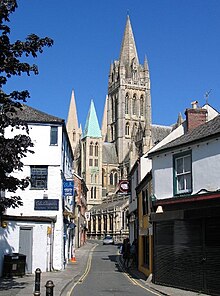
Cornwall's only city, and the home of thecouncil headquarters,is Truro. NearbyFalmouthis notable as a port.St Just in Penwithis the westernmost town in England, though the same claim has been made forPenzance,which is larger.St IvesandPadstoware today small vessel ports with a major tourism and leisure sector in their economies.Newquayon the north coast is another major urban settlement which is known for its beaches and is a popular surfing destination, as isBudefurther north, but Newquay is now also becoming important for its aviation-related industries.Camborneis the county's largest town and more populous than the county town Truro. Together with the neighbouring town ofRedruth,it forms the largest urban area in Cornwall, and both towns were significant as centres of the global tin mining industry in the 19th century; nearby copper mines were also very productive during that period.St Austellis also larger than Truro and was the centre of thechina clayindustry in Cornwall. Until fournew parisheswere created for the St Austell area on 1 April 2009 St Austell was the largest settlement in Cornwall.[46]
Cornwall borders the county ofDevonat the River Tamar. Major roads between Cornwall and the rest of Great Britain are theA38which crosses the Tamar atPlymouthvia theTamar Bridgeand the town ofSaltash,theA39 road(Atlantic Highway) fromBarnstaple,passing throughNorth Cornwallto end in Falmouth, and theA30which connects Cornwall to theM5 motorwayatExeter,crosses the border south ofLaunceston,crosses Bodmin Moor and connects Bodmin, Truro, Redruth, Camborne, Hayle and Penzance.Torpoint Ferrylinks Plymouth withTorpointon the opposite side of theHamoaze.A rail bridge, theRoyal Albert Bridgebuilt byIsambard Kingdom Brunel(1859), provides the other main land transport link. The city of Plymouth, a large urban centre in south west Devon, is an important location for services such as hospitals, department stores, road and rail transport, and cultural venues, particularly for people living in east Cornwall.
CardiffandSwansea,across the Bristol Channel, have at some times in the past been connected to Cornwall by ferry, but these do not operate now.[47]
TheIsles of Scillyare served by ferry (from Penzance) and by aeroplane, having its own airport:St Mary's Airport.There are regular flights between St Mary's andLand's End Airport,near St Just, andNewquay Airport;during the summer season, a service is also provided between St Mary's andExeter Airport,in Devon.
Ecology
[edit]Flora and fauna
[edit]Cornwall has varied habitats including terrestrial and marine ecosystems. One noted species in decline locally is theReindeer lichen,which species has been made a priority for protection under the national UKBiodiversity Action Plan.[48][49]
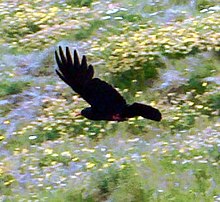
Botanists divide Cornwall and Scilly into two vice-counties: West (1) and East (2). The standard flora is byF. H. DaveyFlora of Cornwall(1909). Davey was assisted byA. O. Humeand he thanks Hume, his companion on excursions in Cornwall and Devon, and for help in the compilation of that Flora, publication of which was financed by him.
Climate
[edit]Cornwall has atemperateOceanic climate(Köppen climate classification:Cfb), with mild winters and cool summers. Cornwall has the mildest and one of the sunniest climates of the United Kingdom, as a result of its oceanic setting and the influence of theGulf Stream.[50]The average annual temperature in Cornwall ranges from 11.6 °C (52.9 °F) on theIsles of Scillyto 9.8 °C (49.6 °F) in the central uplands. Winters are among the warmest in the country due to the moderating effects of the warm ocean currents, and frost and snow are very rare at the coast and are also rare in the central upland areas. Summers are, however, not as warm as in other parts of southern England.[51]The surrounding sea and its southwesterly position mean that Cornwall's weather can be relatively changeable.
Cornwall is one of the sunniest areas in the UK. It has more than 1,541 hours of sunshine per year, with the highest average of 7.6 hours of sunshine per day in July.[52]The moist, mild air coming from the southwest brings higher amounts of rainfall than in eastern Great Britain, at 1,051 to 1,290 mm (41.4 to 50.8 in) per year. However, this is not as much as in more northern areas of the west coast.[53]The Isles of Scilly, for example, where there are on average fewer than two days of air frost per year, is the only area in the UK to be in theHardiness zone10. The islands have, on average, less than one day of air temperature exceeding 30 °C per year and are in the AHS Heat Zone 1. Extreme temperatures in Cornwall are particularly rare; however, extreme weather in the form of storms and floods is common. Due to climate change Cornwall faces more heatwaves and severe droughts, faster coastal erosion, stronger storms and higher wind speeds as well as the possibility of more high impact flooding.[54]
Culture
[edit]Language
[edit]Cornish language
[edit]
Cornish, a member of theBrythonic branchof theCeltic language family,died out as a first language in the late 18th century. In the 20th and 21st centuries, it has beenrevivedby a small number of speakers. It is closely related to the other Brythonic languages (BretonandWelsh), and less so to theGoidelic languages.Cornish has no legal status in the UK.
There has been a revival of the language by academics and optimistic enthusiasts since the mid-19th century that gained momentum from the publication in 1904 ofHenry Jenner'sHandbook of the Cornish Language.It is a social networking community language rather than a social community group language.[55]Cornwall Council encourages and facilitates language classes within the county, in schools and within the wider community.[56]
In 2002, Cornish was named as a UK regional language in theEuropean Charter for Regional or Minority Languages.[57]As a result, in 2005 its promoters received limited government funding.[58]Several words originating in Cornish are used in the mining terminology of English, such ascostean,gossan,[59]gunnies,kibbal,[60]kieve[61]andvug.[62]
English dialect
[edit]The Cornish language and culture influenced the emergence of particular pronunciations and grammar not used elsewhere in England. The Cornish dialect is spoken to varying degrees; however, someone speaking in broad Cornish may be practically unintelligible to one not accustomed to it. Cornish dialect has generally declined, as in most places it is now little more than a regional accent and grammatical differences have been eroded over time. Marked differences in vocabulary and usage still exist between the eastern and western parts of Cornwall.
Flag
[edit]
Saint Piran's Flag is the national flag and ancient banner of Cornwall,[63][64][65]and an emblem of the Cornish people. The banner of Saint Piran is a white cross on a black background (in terms ofheraldry'sable, a cross argent'). According to legend Saint Piran adopted these colours from seeing the white tin in the black coals and ashes during his discovery of tin.[63][66]The Cornish flag is an exact reverse of the formerBretonblack crossnational flagand is known by the same name "Kroaz Du".[67][68]

Arts and media
[edit]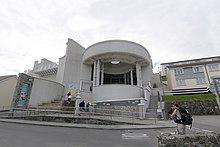
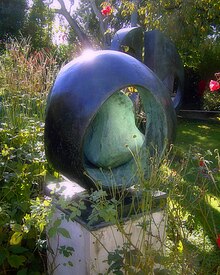
Since the 19th century, Cornwall, with its unspoilt maritime scenery and strong light, has sustained a vibrant visual art scene of international renown. Artistic activity within Cornwall was initially centred on the art-colony ofNewlyn,most active at the turn of the 20th century. ThisNewlyn Schoolis associated with the names ofStanhope Forbes,Elizabeth Forbes,[69]Norman GarstinandLamorna Birch.[70]Modernist writers such asD. H. LawrenceandVirginia Woolflived in Cornwall between the wars,[71]andBen Nicholson,the painter, having visited in the 1920s came to live in St Ives with his then wife, the sculptorBarbara Hepworth,at the outbreak of theSecond World War.[72]They were later joined by the Russian emigrantNaum Gabo,[73]and other artists. These includedPeter Lanyon,Terry Frost,Patrick Heron,Bryan WynterandRoger Hilton.St Ives also houses the Leach Pottery, whereBernard Leach,and his followers championed Japanese inspired studio pottery.[74]Much of this modernist work can be seen inTate St Ives.[75]The Newlyn Society andPenwith Society of Artscontinue to be active, and contemporary visual art is documented in a dedicated online journal.[76]
Local television programmes are provided byBBC South West[77]&ITV West Country.[78]Radio programmes are produced byBBC Radio Cornwallin Truro for the entire county,Heart West,Source FMfor the Falmouth and Penryn areas,Coast FMfor west Cornwall,Radio St Austell Bayfor the St Austell area,NCB Radiofor north Cornwall &Pirate FM.[79]
Music
[edit]Cornwall has afolk musictradition that has survived into the present and is well known for its unusual folk survivals such asMummers Plays,theFurry DanceinHelstonplayed by the famousHelston Town Band,andObby OssinPadstow.
Newlynis home to a food and music festival[80]that hosts live music, cooking demonstrations, and displays of locally caught fish.
As in other former mining districts of Britain, male voice choirs andbrass bands,such asBrass on the Grassconcerts during the summer atConstantine,are still very popular in Cornwall. Cornwall also has around 40 brass bands, including the six-times National Champions of Great Britain, Camborne Youth Band, and the bands ofLannerand St Dennis.
Cornish players are regular participants in inter-Celtic festivals, and Cornwall itself has several inter-Celtic festivals such asPerranporth's Lowender Peran folk festival.[81]
Contemporary musicianRichard D. James(also known as Aphex Twin) grew up in Cornwall, as didLuke VibertandAlex Parks,winner ofFame Academy2003.Roger Taylor,the drummer from the bandQueenwas also raised in the county, and currently lives not far fromFalmouth.The American singer-songwriterTori Amosnow resides predominantly in North Cornwall not far from Bude with her family.[82]Thelutenist,composer and festival directorBen Salfieldlives in Truro.Mick FleetwoodofFleetwood Macwas born inRedruth.
Literature
[edit]Cornwall's rich heritage and dramatic landscape have inspired numerous writers.
Fiction
[edit]Sir Arthur Quiller-Couch,author of many novels and works of literary criticism, lived in Fowey: his novels are mainly set in Cornwall.Daphne du Maurierlived atMenabillynear Fowey and many of her novels had Cornish settings:The Loving Spirit,Jamaica Inn,Rebecca,Frenchman's Creek,The King's General(partially),My Cousin Rachel,The House on the StrandandRule Britannia.[83]She is also noted for writingVanishing Cornwall.Cornwall provided the inspiration forThe Birds,one of her terrifying series of short stories, made famous as a film byAlfred Hitchcock.[84]
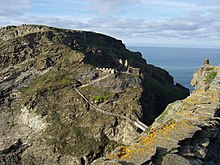
Conan Doyle'sThe Adventure of the Devil's FootfeaturingSherlock Holmesis set in Cornwall.[85]Winston Graham's seriesPoldark,Kate Tremayne'sAdam Lovedayseries,Susan Cooper's novelsOver Sea, Under Stone[86]andGreenwitch,andMary Wesley'sThe Camomile Lawnare all set in Cornwall. Writing under the pseudonym of Alexander Kent,Douglas Reemansets parts of hisRichard Bolithoand Adam Bolitho series in the Cornwall of the late 18th and the early 19th centuries, particularly in Falmouth.Gilbert K. Chestertonplaced the action of many of his stories there.
Medieval Cornwall is the setting of the trilogy byMonica Furlong,Wise Child,JuniperandColman,as well as part of Charles Kingsley'sHereward the Wake.
Hammond Innes's novel,The Killer Mine;[87]Charles de Lint's novelThe Little Country;[88]and Chapters 24–25 ofJ. K. Rowling'sHarry Potter and the Deathly Hallowstake place in Cornwall (Shell Cottage, on the beach outside the fictional village of Tinworth).[89]
David Cornwell, who wrote espionage novels under the nameJohn le Carré,lived and worked in Cornwall.[90]Nobel Prize-winningnovelistWilliam Goldingwas born inSt Columb Minorin 1911, and returned to live near Truro from 1985 until his death in 1993.[91]D. H. Lawrencespent a short time living in Cornwall.Rosamunde Pilchergrew up in Cornwall, and several of her books take place there.
St. Michael's Mountin Cornwall (under the fictional name of Mount Polbearne) is the setting of the Little Beach Street Bakery series byJenny Colgan,[92]who spent holidays in Cornwall as a child.[93]The book series includesLittle Beach Street Bakery(2014),Summer at Little Beach Street Bakery(2015),Christmas at Little Beach Street Bakery(2016), andSunrise by the Sea(2021).
In thePaddington Bearnovels byMichael Bondthe title character is said to have landed at an unspecified port in Cornwall having travelled in alifeboataboard acargo shipfrom darkestPeru.From here he travels toLondonon a train and eventually arrives atPaddington Station.[94]
Enid Blyton's 1953 novelFive Go Down to the Sea(the twelfth book inThe Famous Fiveseries) is set in Cornwall, near the fictional coastal village of Tremannon.
Poetry
[edit]
The latePoet LaureateSir John Betjemanwas famously fond of Cornwall and it featured prominently in his poetry. He is buried in the churchyard atSt Enodoc's Church, Trebetherick.[95] Charles Causley,the poet, was born in Launceston and is perhaps the best known of Cornish poets.Jack Clemoand the scholarA. L. Rowsewere also notable Cornishmen known for their poetry; The Rev.R. S. Hawkerof Morwenstow wrote some poetry which was very popular in the Victorian period.[96]The Scottish poetW. S. Grahamlived in West Cornwall from 1944 until his death in 1986.[97]
The poetLaurence Binyonwrote "For the Fallen" (first published in 1914) while sitting on the cliffs betweenPentire Pointand The Rumps and a stone plaque was erected in 2001 to commemorate the fact. The plaque bears the inscription "FOR THE FALLEN / Composed on these cliffs, 1914". The plaque also bears below this the fourth stanza (sometimes referred to as"The Ode") of the poem:
- They shall grow not old, as we that are left grow old
- Age shall not weary them, nor the years condemn
- At the going down of the sun and in the morning
- We will remember them
Other literary works
[edit]Cornwall produced a substantial number ofpassion playssuch as theOrdinaliaduring the Middle Ages. Many are still extant, and provide valuable information about the Cornish language. See alsoCornish literature
Colin Wilson,a prolific writer who is best known for his debut workThe Outsider(1956) and forThe Mind Parasites(1967), lived inGorran Haven,a small village on the southern Cornish coast. The writerD. M. Thomaswas born in Redruth but lived and worked in Australia and the United States before returning to his native Cornwall. He has written novels, poetry, and other works, including translations from Russian.
Thomas Hardy's dramaThe Queen of Cornwall(1923) is a version of the Tristan story; the second act ofRichard Wagner's operaTristan und Isoldetakes place in Cornwall, as doGilbert and Sullivan's operettasThe Pirates of PenzanceandRuddigore.
Clara Vyvyanwas the author of various books about many aspects of Cornish life such asOur Cornwall.She once wrote: "The Loneliness of Cornwall is a loneliness unchanged by the presence of men, its freedoms a freedom inexpressible by description or epitaph. Your cannot say Cornwall is this or that. Your cannot describe it in a word or visualise it in a second. You may know the country from east to west and sea to sea, but if you close your eyes and think about it no clear-cut image rises before you. In this quality of changefulness have we possibly surprised the secret of Cornwall's wild spirit—in this intimacy the essence of its charm? Cornwall!".[98] A level ofTomb Raider: Legend,a game dealing with Arthurian Legend, takes place in Cornwall at a museum above King Arthur's tomb. The adventure gameThe Lost Crownis set in the fictional town of Saxton, which uses the Cornish settlements of Polperro, Talland and Looe as its model.[99]
The fairy taleJack the Giant Killertakes place in Cornwall.[100]
The Mousehole Cat,a children's book written byAntonia Barberand illustrated byNicola Bayley,is set in the Cornish villageMouseholeand based on the legend ofTom Bawcockand the continuing tradition ofTom Bawcock's Eve.
Sports
[edit]
The main sports played in Cornwall arerugby,footballandcricket.Athletes from Truro have done well inOlympicandCommonwealth Gamesfencing, winning several medals.Surfingis popular, particularly with tourists, thousands of whom take to the water throughout the summer months. Some towns and villages have bowling clubs, and a wide variety of British sports are played throughout Cornwall. Cornwall is also one of the fewplacesin England whereshintyis played; theEnglish Shinty Associationis based inPenryn.
TheCornwall County Cricket Clubplays as one of theminor counties of English cricket.[101]
Truro, and all of the towns and some villages havefootballclubs belonging to theCornwall County Football Association,and some clubs have teams competing higher within theEnglish football league pyramid.[102]Of these, the highest ranked — by two flights — isTruro City F.C.,who will be playing in theNational League Southin the 2023–24 season.[103]Other notable Cornish teams includeMousehole A.F.C.,Helston Athletic F.C.,andFalmouth Town F.C.[102]
Rugby football
[edit]Viewed as an "important identifier of ethnic affiliation",rugby unionhas become a sport strongly tied to notions of Cornishness.[104]and since the 20th century,rugby unionhas emerged as one of the most popular spectator and team sports in Cornwall (perhaps the most popular), with professional Cornish rugby footballers being described as a "formidable force",[101]"naturally independent, both in thought and deed, yet paradoxically staunch English patriots whose top players have represented England with pride and passion".[105]
In 1985, sports journalistAlan Gibsonmade a direct connection between the love of rugby in Cornwall and the ancient parish games of hurling and wrestling that existed for centuries before rugby officially began.[105]Among Cornwall's native sports are a distinctive form of Celtic wrestling related toBretonwrestling, andCornish hurling,a kind of mediaeval football played with a silver ball (distinct fromIrish Hurling).Cornish Wrestlingis Cornwall's oldest sport and as Cornwall's native tradition it has travelled the world to places likeVictoria, AustraliaandGrass Valley, Californiafollowing the miners andgold rushes.Cornish hurling now takes place atSt. Columb Major,St Ives,and less frequently atBodmin.[d]
Inrugby league,Cornwall R.L.F.C.,founded in 2021, will represent the county in the professional league system. The semi-pro club will start in the third tierRFL League 1.[106]At an amateur level, the county is represented byCornish Rebels.
Surfing and watersports
[edit]

Due to its long coastline, various maritime sports are popular in Cornwall, notably sailing andsurfing.International events in both are held in Cornwall. Cornwall hosted the Inter-CelticWatersportsFestival in 2006. Surfing in particular is very popular, as locations such asBudeandNewquayoffer some of the best surf in the UK.Pilot gigrowing has been popular for many years and the World championships takes place annually on theIsles of Scilly.On 2 September 2007, 300 surfers atPolzeathbeach set a new world record for the highest number of surfers riding the same wave as part of the Global Surf Challenge and part of a project called Earthwave to raise awareness aboutglobal warming.[107]
Fencing
[edit]As its population is comparatively small, and largely rural, Cornwall's contribution to British nationalsport in the United Kingdomhas been limited;[101]the county's greatest successes have come in fencing. In 2014, half of the men's GB team fenced for Truro Fencing Club, and 3 Truro fencers appeared at the 2012 Olympics.[108]
Cuisine
[edit]Cornwall has a strong culinary heritage. Surrounded on three sides by the sea amid fertile fishing grounds, Cornwall naturally has fresh seafood readily available;Newlynis the largest fishing port in the UK by value of fish landed, and is known for its wide range of restaurants.[109]Television chefRick Steinhas long operated a fish restaurant inPadstowfor this reason, andJamie Oliverchose to open his second restaurant,Fifteen,inWatergate BaynearNewquay.MasterChefhost and founder of Smiths of Smithfield,John Torode,in 2007 purchased Seiners inPerranporth.One famous local fish dish isStargazy pie,a fish-based pie in which the heads of the fish stick through the piecrust, as though "star-gazing". The pie is cooked as part of traditional celebrations forTom Bawcock's Eve,but is not generally eaten at any other time.
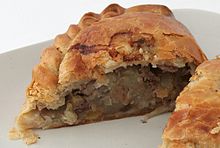
Cornwall is perhaps best known though for itspasties,a savoury dish made with pastry. Today's pasties usually contain a filling of beef steak, onion, potato andswedewith salt and white pepper, but historically pasties had a variety of different fillings. "Turmut, 'tates and mate" (i.e. "Turnip, potatoes and meat", turnip being the Cornish and Scottish term for swede, itself an abbreviation of 'Swedish Turnip', the British term forrutabaga) describes a filling once very common. For instance, the licky pasty contained mostly leeks, and the herb pasty contained watercress, parsley, and shallots.[110]Pasties are often locally referred to asoggies.Historically, pasties were also often made with sweet fillings such as jam, apple and blackberry, plums or cherries.[111] The wet climate and relatively poor soil of Cornwall make it unsuitable for growing many arable crops. However, it is ideal for growing the rich grass required for dairying, leading to the production of Cornwall's other famous export,clotted cream.This forms the basis for many local specialities including Cornishfudgeand Cornishice cream.Cornish clotted cream hasProtected Geographical Statusunder EU law,[112]and cannot be made anywhere else. Its principal manufacturer isA. E. Rodda & Sonof Scorrier.
Local cakes and desserts includeSaffron cake,Cornish heavy (hevva) cake,Cornish fairingsbiscuits, figgy 'obbin,Cream teaand whortleberry pie.[113][114][115]
There are also many types of beers brewed in Cornwall—those produced bySharp's Brewery,Skinner's Brewery,Keltek Brewery andSt Austell Breweryare the best known—includingstouts,alesand other beer types. There is some small scale production of wine,meadandcider.
Politics and administration
[edit]Cornish national identity
[edit]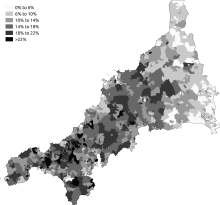
Cornwall is recognised by Cornish and Celtic political groups as one of six Celtic nations, alongsideBrittany,Ireland, theIsle of Man,Scotland and Wales.[116][117][118][119](TheIsle of Man Governmentand theWelsh Governmentalso recogniseAsturiasandGalicia.[120][121]) Cornwall is represented, as one of the Celtic nations, at theFestival Interceltique de Lorient,an annual celebration of Celtic culture held in Brittany.[122]
Cornwall Council consider Cornwall's unique cultural heritage and distinctiveness to be one of the area's major assets. They see Cornwall's language, landscape, Celtic identity, political history, patterns of settlement, maritime tradition, industrial heritage, and non-conformist tradition, to be among the features making up its "distinctive" culture.[123]However, it is uncertain exactly how many of the people living in Cornwall consider themselves to be Cornish; results from different surveys (including the national census) have varied. In the2001 census,7 per cent of people in Cornwall identified themselves as Cornish, rather than British or English. However, activists have argued that this underestimated the true number as there was no explicit "Cornish" option included in the official census form.[124]Subsequent surveys have suggested that as many as 44 per cent identify as Cornish.[125]Many people in Cornwall say that this issue would be resolved if a Cornish option became available on the census.[126]The question and content recommendations for the2011 censusprovided an explanation of the process of selecting an ethnic identity which is relevant to the understanding of the often quoted figure of 37,000 who claimed Cornish identity.[127]The2021 censusfound that 17% of people in Cornwall identified as being Cornish (89,000), with 14% of people in Cornwall identifying as Cornish-only (80,000).[128]Again there was no tick-box provided, and "Cornish" had to be written-in as "Other".[128][129]
On 24 April 2014 it was announced that Cornish people have been granted minority status under theEuropeanFramework Convention for the Protection of National Minorities.[130]
Local politics
[edit]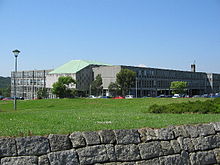
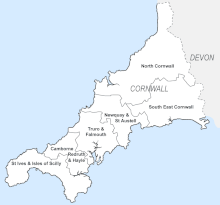
Theceremonial countyof Cornwall is made up of two local government districts; mainland Cornwall, governed byCornwall Council,and theIsles of Scilly.[131]Cornwall Council, formerlyCornwall County Counciluntil 2009, is aunitary authoritybased atLys KernowinTruro.The Isles of Scilly are governed by thesui generisCouncil of the Isles of Scillybased inHugh Town,[132][133]and have been administered by their own unitary authority since 1890. They are grouped with Cornwall for other administrative purposes, such as theNational Health ServiceandDevon and Cornwall Police.[134][135][136]The county's Crown Courtis based at the Courts of Justice in Truro. Magistrates' Courts are found in Truro (but at a different location to the Crown Court) and atBodmin.
Cornwall County Council was established in 1889 under theLocal Government Act 1888,and theLocal Government Act 1972reorganised the county's second tier of administration with the formation of six district councils:Caradon,Carrick,Kerrier,North Cornwall,Penwith,andRestormel.In 2009,structural changes to local government in Englandresulted in the abolition of the six district councils and turned Cornwall Council into a unitary authority. While projected to streamline services, cutred tapeand save around £17 million a year, the reorganisation was met with wide opposition, with a poll in 2008 showing 89% disapproval from Cornish residents.[137][138][139]
Thefirst electionsfor the unitary authority were held on 4 June 2009. At themost recent council election in 2021,theConservative Partywon 47 of the 87 seats. Also elected were 16independentcouncillors, 13Liberal Democrats,five from theLabour Party,five fromMebyon Kernowand oneGreen Partyrepresentative. Before the creation of the unitary council, the former county council had 82 seats, the majority of which were held by the Liberal Democrats, elected at the2005 county council elections.The six former districts had a total of 249 council seats, and the groups with greatest numbers of councillors were Liberal Democrats, Conservatives and Independents.
Parliament and national politics
[edit]Until 1832, Cornwall was represented by 44Members of Parliament(MPs) in theHouse of Commons—more than any other county—reflecting the importance of tin mining to the Crown.[140]Most of the increase in numbers of MPs came between 1529 and 1584 after which there was no change until theReform Act 1832,[141]which enacted widespread changes to the country'selectoral systemand reduced Cornwall's number of MPs to 14. This was reduced further in subsequentboundary commissionreviews to better reflect Cornwall's population. The county is currently divided intosix county constituencies.
TheLiberal Partyand its successor, the Liberal Democrats, have traditionally been popular in Cornwall; the Liberals won every Cornish seat in1906andJanuary 1910,and again in1929despite the party finishing third nationally. The Liberal Democrats won every seat in the county in2005,but lost seats to the Conservatives in2010before being wiped out in2015.The Conservatives won all six Cornish seats in 2015,2017and2019.Following expectation of a Conservative defeat at the2024 general election,Cornwall was considered a three-party battleground.[142]The Conservatives lost all six seats and the county is currently represented by four Labour and two Liberal Democrat MPs.
Although Cornwall does not have a designated government department, in 2007 whileLeader of the OppositionDavid Cameron created a Shadow Secretary of State for Cornwall. The position was not made into a formal UK Cabinet position when Cameron entered government following the2010 United Kingdom general election[143]
| Party | Votes (%) | |||||
|---|---|---|---|---|---|---|
| 2010 | 2015 | 2017 | 2019 | 2024 | ||
| Labour | 24,257(8.6%) | 36,235(12.3%) | 83,968(26.7%) | 74,392(23.1%) | 77,517(26.3%) | |
| Conservative | 115,016(40.9%) | 127,079(43.1%) | 152,428(48.4%) | 173,117(53.7%) | 76,817(26.1%) | |
| Liberal Democrat | 117,307(41.8%) | 66,056(22.4%) | 73,875(23.5%) | 62,169(19.3%) | 73,691(25.0%) | |
| Reform | n/a | n/a | n/a | n/a | 48,574(16.5%) | |
| Green | 3,573(1.3%) | 17,241(5.8%) | 3,218(1.0%) | 7,139(2.2%) | 13,778(4.7%) | |
| UKIP | 13,763(4.9%) | 40,785(13.8%) | 897(0.3%) | n/a | 111(0.0%) | |
| Others | 6,965(2.5%) | 7,432(2.5%) | 323(0.1%) | 5,262(1.6%) | 3,740(1.3%) | |
| Total | 280,881 | 294,828 | 314,709 | 322,079 | 294,228 | |
Devolution movement
[edit]Cornish nationalists have organised into two political parties:Mebyon Kernow,formed in 1951, and theCornish Nationalist Party.In addition to the political parties, there are various interest groups such as theRevived Cornish Stannary Parliamentand theCeltic League.The Cornish Constitutional Convention was formed in 2000 as a cross-party organisation including representatives from the private, public and voluntary sectors to campaign for the creation of aCornish Assembly,[144][145]along the lines of theNational Assembly for Wales,Northern Ireland Assemblyand theScottish Parliament.Between 5 March 2000 and December 2001, the campaign collected the signatures of 41,650 Cornish residents endorsing the call for a devolved assembly, along with 8,896 signatories from outside Cornwall. The resulting petition was presented to the Prime Minister,Tony Blair.[144]
Emergency services
[edit]- Devon and Cornwall Police
- Cornwall Fire and Rescue Service
- South Western Ambulance Service
- Cornwall Air Ambulance
- HM Coastguard
- Cornwall Search & Rescue Team
- British Transport Police
Economy
[edit]
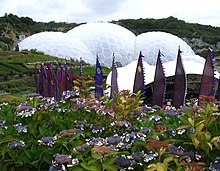
Cornwall is one of the poorest parts of the United Kingdom in terms of per capita GDP and average household incomes. At the same time, parts of the county, especially on the coast, have high house prices, driven up by demand from relatively wealthy retired people and second-home owners.[146]TheGVAper head was 65% of the UK average for 2004.[147]The GDP per head for Cornwall and theIsles of Scillywas 79.2% of the EU-27 average for 2004, the UK per head average was 123.0%.[148]In 2011, the latest available figures, Cornwall's (including the Isles of Scilly) measure of wealth was 64% of the European average per capita.[149]
Historicallymining of tin(and later also of copper) was important in the Cornish economy. The first reference to this appears to be by Pytheas:see above.Julius Caesarwas the last classical writer to mention thetintrade, which appears to have declined during the Roman occupation.[150]The tin trade revived in the Middle Ages and its importance to the Kings of England resulted in certain privileges being granted to the tinners; theCornish rebellion of 1497is attributed to grievances of the tin miners.[151]In the mid-19th century, however, the tin trade again fell into decline. Otherprimary sectorindustriesthat have declined since the 1960s includechina clayproduction, fishing and farming.
Today, the Cornish economy depends heavily on its tourist industry, which makes up around a quarter of the economy. The official measures of deprivation and poverty at district and 'sub-ward' level show that there is great variation in poverty and prosperity in Cornwall with some areas among the poorest in England and others among the top half in prosperity. For example, the ranking of 32,482 sub-wards in England in the index of multiple deprivation (2006) ranged from 819th (part of Penzance East) to 30,899th (part of Saltash Burraton in Caradon), where the lower number represents the greater deprivation.[152][153]
Cornwall was one of two UK areas designated as 'less developed regions' by theEuropean Union,which, prior toBrexit,meant the area qualified for EU Cohesion Policy grants.[154]It was grantedObjective 1status by theEuropean Commissionfor 2000 to 2006,[155]followed by further rounds of funding known as 'Convergence Funding' from 2007 to 2013[156]and 'Growth Programme' for 2014 to 2020.[157]
Tourism
[edit]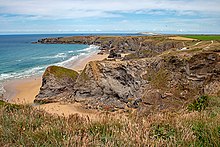
Cornwall has a tourism-based seasonal economy which is estimated to contribute up to[clarification needed]24% of Cornwall's gross domestic product.[158]In 2011 tourism brought £1.85 billion into the Cornish economy.[159]Cornwall's unique culture, spectacular landscape and mild climate make it a popular tourist destination, despite being somewhat distant from the United Kingdom's main centres of population. Surrounded on three sides by theEnglish ChannelandCeltic Sea,Cornwall has many miles of beaches and cliffs; theSouth West Coast Pathfollows a complete circuit of both coasts. Other tourist attractions include moorland, country gardens, museums, historic and prehistoric sites, and wooded valleys. Five million tourists visit Cornwall each year, mostly drawn from within the UK.[160]Visitors to Cornwall are served by the airport atNewquay,whilst private jets, charters and helicopters are also served byPerranporthairfield; nightsleeper and daily rail services run between Cornwall, London and other regions of the UK.
Newquay andPorthtowanare popular destinations for surfers. In recent years, theEden ProjectnearSt Austellhas been a major financial success, drawing one in eight of Cornwall's visitors in 2004.[161]
In the summer of 2018, due to the recognition of its beaches and weather through social media and the marketing of travel companies, Cornwall received about 20 per cent more visitors than the usual 4.5 million figure. The sudden rise and demand of tourism in Cornwall caused multiple traffic and safety issues in coastal areas.[162]
In October 2021, Cornwall was longlisted for theUK City of Culture2025, but failed to make the March 2022 shortlist.[163]
Fishing
[edit]
Other industries includefishing,although this has been significantly re-structured by EU fishing policies (as of 2010[update]the Southwest Handline Fishermen's Association has started to revive the fishing industry).[164]
Agriculture
[edit]Agriculture, once an important part of the Cornish economy, has declined significantly relative to other industries. However, there is still a strong dairy industry, with products such as Cornishclotted cream.
Mining
[edit]
Mining of tin and copper was also an industry, but today the derelict mine workings survive only as aWorld Heritage Site.[165]However, theCamborne School of Mines,which was relocated toPenrynin 2004, is still a world centre of excellence in the field of mining and applied geology[166]and the grant of World Heritage status has attracted funding for conservation and heritage tourism.[167]China clayextraction has also been an important industry in the St Austell area, but this sector has been in decline, and this, coupled with increased mechanisation, has led to a decrease in employment in this sector, although the industry still employs around 2,133 people in Cornwall, and generates over £80 million to the local economy.[168]
In March 2016, a Canadian company, Strongbow Exploration, had acquired, from administration, a 100% interest in theSouth Croftytin mine and the associated mineral rights in Cornwall with the aim of reopening the mine and bringing it back to full production.[169]Work is currently ongoing to build a water filtration plant in order to dewater the mine.
Internet
[edit]Cornwall is the landing point for twenty-two of the world's fastest high-speed undersea and transatlantic fibre optic cables, making Cornwall an important hub within Europe's Internet infrastructure.[170]TheSuperfast Cornwallproject completed in 2015,[171]and saw 95% of Cornish houses and businesses connected to a fibre-based broadband network, with over 90% of properties able to connect with speeds above 24 Mbit/s.[172]
Aerospace
[edit]The county's newest industry is aviation:Newquay Airportis the home of a growing business park with Enterprise Zone status, known as Aerohub. Also a space launch facility,Spaceport Cornwall,has been established at Newquay, in partnership with Goonhilly satellite tracking station near Helston in south Cornwall.[173]
Demographics
[edit]
Cornwall's population was 537,400 in the2011 census,with a population density of 144 people per square kilometre, ranking it 40th and 41st, respectively,[clarification needed]among the 47 counties of England. Cornwall's population was 95.7%White Britishand has a relatively high rate of population growth. At 11.2% in the 1980s and 5.3% in the 1990s, it had the fifth-highest population growth rate of the counties of England.[174]The natural change has been a small population decline, and the population increase is due to inward migration into Cornwall.[175]According to the 1991 census, the population was 469,800.
Cornwall has a relatively high retired population, with 22.9% of pensionable age, compared with 20.3% for the United Kingdom as a whole.[176]This may be due partly to Cornwall's rural and coastal geography increasing its popularity as a retirement location, and partly to outward migration of younger residents to more economically diverse areas.[original research?]
Education
[edit]

Over 10,000 students attend Cornwall's two universities,Falmouth Universityand theUniversity of Exeter(includingCamborne School of Mines). Falmouth University is a specialistpublic universityfor the creative industries and arts, while the University Of Exeter has two campuses in Cornwall, Truro andPenryn,the latter shared with Falmouth. Penryn campus is home to educational departments such as the rapidly growing Centre for Ecology andConservation(CEC), the Environment and Sustainability Institute (ESI), and theInstitute of Cornish Studies.
Cornwall has a comprehensive education system, with 31 state and eight independent secondary schools. There are three further education colleges:Truro and Penwith College,Cornwall CollegeandCallywith Collegewhich opened in September 2017. The Isles of Scilly only has one school, while the former Restormel district has the highest school population, and school year sizes are around 200, with none above 270. Before the introduction of comprehensive schools there were a number of grammar schools and secondary modern schools, e.g. the schools that later becameSir James Smith's SchoolandWadebridge School.There are also primary schools in many villages and towns: e.g.St Mabyn Church of England Primary School.
See also
[edit]- Christianity in Cornwall
- Index of Cornwall-related articles
- Outline of Cornwall– overview of the wide range of topics covered by this subject
- Tamar Valley AONB
- Duchy of Cornwall
Notes
[edit]- ^Eilert Ekwallwho studied the place-names of England in the 1930s and 40s gives the following forms: Cornubia in Vita Melori &c.; Middle Welsh Cerniu; Welsh Cernyw; Cornish: Kernow; (on) Cornwalum ASC 891; Cornwealum ASC(E) 997; "The Brit name goes back to *Cornavia probably derived from the tribal name Cornovii. OE Cornwealas means 'the Welsh in Cornwall' this folk-name later became the name of the district".[12]
- ^"Wales"is derived from theProto-GermanicwordWalhaz,meaning "Romanised foreigner"; throughOld Englishwelisċ,wælisċ,wilisċ,meaning "Romano-British";toModern EnglishWelsh.The same etymology applies to Cornwall and toWalloniain Belgium.[43]
- ^Britain's only other example of an ophiolite, the Shetland ophiolite, is older, and linked to the GrampianOrogeny.
- ^The Bodmin hurl is held whenever the ceremony ofbeating the boundstakes place: each occasion must be five years or more after the last one.
References
[edit]- ^"No. 64352".The London Gazette.22 March 2024. p. 5930.
- ^"Mid-2022 population estimates by Lieutenancy areas (as at 1997) for England and Wales".Office for National Statistics.24 June 2024.Retrieved26 June2024.
- ^UK Census(2021)."2021 Census Area Profile – Cornwall Local Authority (E06000052)".Nomis.Office for National Statistics.Retrieved4 June2024.
- ^"Mid-Year Population Estimates, UK, June 2022".Office for National Statistics.26 March 2024.Retrieved3 May2024.
- ^"Meaning of Cornwall in English".Oxforddictionaries.com. Archived fromthe originalon 12 June 2021.Retrieved3 March2022.
- ^Gerlyver Kernewek (FSS) Cornish Dictionary (SWF).Cornwall Council, Truro, Cornwall, UK. 2018. p. 95.
- ^"Interpretation Act 1978: Schedule 1",legislation.gov.uk,The National Archives,1978 c. 30 (sch. 1),retrieved16 February2024,
"England" means, subject to any alteration of boundaries under Part IV of the Local Government Act 1972, the area consisting of the counties established by section 1 of that Act, Greater London and the Isles of Scilly. [1st April 1974].
- ^"Cornwall".Online Etymology Dictionary.Archivedfrom the original on 27 September 2013.Retrieved21 May2013.
- ^"Horn".Online Etymology Dictionary.Archivedfrom the original on 27 September 2013.Retrieved21 May2013.
- ^Payton, Philip(2004).Cornwall: a history(revised ed.). Fowey: Cornwall Editions Ltd.ISBN1-904880-00-2.
- ^Charles Thomas.(1986).Celtic Britain.(Ancient Peoples & Places Series.) London: Thames & Hudson
- ^Ekwall, E.,The Concise Dictionary of English Place-names,2nd ed., 1940, p. 117a.
- ^"Cornish History – Stone Age to Present Day".www.cornwalls.co.uk.Retrieved17 January2022.
- ^Barry Cunliffe; John T. Koch, eds. (2010).Celtic from the West: Alternative Perspectives from Archaeology, Genetics, Language and Literature.Oxbow Books and Celtic Studies Publications. p. 384.ISBN978-1-84217-410-4.Archived fromthe originalon 12 June 2010.
- ^Cunliffe, Barry (2009). "A Race Apart: Insularity and Connectivity".Proceedings of the Prehistoric Society.75.The Prehistoric Society: 55–64.doi:10.1017/S0079497X00000293.S2CID192963510.
- ^Payton (2004), p. 40.
- ^Halliday (1959), p. 51.
- ^Halliday (1959), p. 52.
- ^Champion, Timothy (2001). "The appropriation of the Phoenicians in British imperial ideology".Nations and Nationalism.7(4): 451–65.doi:10.1111/1469-8219.00027.
- ^Berger, Daniel; Soles, Jeffrey; Giumlia-Mair, Alessandra; Brügmann, Gerhard; Galili, Ehud; Lockhoff, Nicole; Pernicka, Ernst (2019)."Isotope systematics and chemical composition of tin ingots from Mochlos (Crete) and other Late Bronze Age sites in the eastern Mediterranean Sea: An ultimate key to tin provenance?".PLOS ONE.14(6): e0218326.Bibcode:2019PLoSO..1418326B.doi:10.1371/journal.pone.0218326.PMC6594607.PMID31242218.
- ^Woodyatt, Amy (19 September 2019)."Ancient tin found in Israel has unexpected Cornish links".CNN.Archivedfrom the original on 9 January 2020.Retrieved16 March2020.
- ^Parcero-Oubina, Cesar; Smart, Chris; Fonte, João (25 July 2023)."Remote Sensing and GIS Modelling of Roman Roads in South West Britain".Journal of Computer Applications in Archaeology.6(1): 62–78.doi:10.5334/jcaa.109.hdl:10261/338676.ISSN2514-8362.
- ^"ToposText".topostext.org.Retrieved11 September2023.
- ^Fitzpatrick-Matthews, Keith (1 January 2022)."Britannia in the Ravenna Cosmography: a Reassessment".Academia.edu.
- ^"AD 500 – Tintagel".Archaeology.co.uk. 24 May 2007.Archivedfrom the original on 14 November 2013.Retrieved24 November2013.
- ^abOrme, Nicholas (1991).Unity & Variety: A History of the Church in Devon & Cornwall.University of Exeter.pp. 1–22.ISBN0859893553.
- ^Probert, Duncan (2010).New light on Aldhelm's letter to King Gerent of Dumnonia.Oxbow Books. pp. 110–28.ISBN9781842173572.
- ^"Medieval Sourcebook: The Annales Cambriae 447–954 (The Annals of Wales)".Fordham.edu.Archivedfrom the original on 4 December 2010.Retrieved2 November2015.
- ^Weatherhill, CraigCornovia;p. 10
- ^"The Foundation of the Kingdom of England".Third-millennium-library.com. Archived fromthe originalon 5 October 2011.Retrieved25 September2010.
- ^abFletcher, John (2022).The Western Kingdom: The Birth of Cornwall.The History Press.ISBN978-1803990002.
- ^Annales Cambriae
- ^Keynes, Simon; Lapidge, Michael (tr.) (1983),Alfred the Great: Asser's Life of King Alfred and other contemporary sources,London, Penguin Books, p. 175; cf.ibid,p. 89
- ^Stenton, F. M. (1947)Anglo-Saxon England.Oxford: Clarendon Press; p. 337
- ^Cornish (and Other) Personal Names from the 10th Century Bodmin ManumissionsArchived11 May 2016 at theWayback Machineby Heather Rose Jones
- ^"Welsh Journals Online".Welshjournals.llgc.org.uk.Archivedfrom the original on 31 December 2015.Retrieved2 November2015.
- ^E. M. R. Ditmas,Tristan and Iseult in Cornwall: The Twelfth-century Romance by Beroul Re-told from the Norman French, by E. M. R. Ditmas Together with Notes on Old Cornwall and a Survey of Place Names in the Poem(Forrester Roberts, 1970)
- ^Williams, Ann & Martin, G. H. (2002) (tr.)Domesday Book: a complete translation,London: Penguin, pp. 341–357
- ^Payton (2004), chapter 5.
- ^Matthew, David (July 1924).The Cornish and Welsh Pirates in the Reign of Elizabeth.Vol. 39. The English Historical Review: Oxford University Press. pp. 337–348.
- ^Deacon, Bernard (2007).A Concise History of Cornwall.University of Wales Press. p. 4.ISBN978-0-7083-2032-7.Archivedfrom the original on 31 December 2015.Retrieved16 October2015.
- ^Watts, Victor (2010).The Cambridge Dictionary of English Place-names(1st paperback ed.).Cambridge University Press.p. 158.ISBN978-0-521-16855-7.
- ^Davies, John(1994).A History of Wales.London: Penguin. p. 69.ISBN978-0-14-028475-1.
- ^"The Official Guide to the South West Coast Path".Southwestcoastpath.com. Archived fromthe originalon 11 June 2011.Retrieved25 September2010.
- ^"The Cornish Heath – County Flower".Archived fromthe originalon 30 September 2008.Retrieved5 February2016.
- ^"Town and parishes to get councils".BBC News website.BBC. 5 December 2008.Archivedfrom the original on 6 December 2008.Retrieved6 December2008.
- ^"Fast Ferries connecting Wales & the South West – Severn Link, Fast Ferries Connecting Wales and the South West".Severnlink.com. Archived fromthe originalon 6 November 2015.Retrieved2 November2015.
- ^Price, J. H., Hepton, C. E. L. and Honey, S. I. (1979).The Inshore Benthic Biota of the Lizard Peninsula,south west Cornwall: the marine algae – History; Chlorophyta; Phaeophyta.Cornish Studies;no. 7: pp. 7–37
- ^Bere, Rennie (1982)The Nature of Cornwall.Buckingham: Barracuda Books
- ^"UK climate information".Met Office. 1 May 2014. Archived fromthe originalon 4 March 2010.Retrieved2 November2015.
- ^"South West England: climate".Met Office.Archivedfrom the original on 11 December 2018.Retrieved18 March2019.
- ^"UK climate information".Met Office. 1 May 2014. Archived fromthe originalon 4 March 2010.Retrieved2 November2015.
- ^"UK climate information".Met Office. 1 May 2014. Archived fromthe originalon 4 March 2010.Retrieved2 November2015.
- ^"The impact of climate change - Cornwall Council".www.cornwall.gov.uk.Retrieved25 October2023.
- ^"Cornish in United Kingdom".European Commission. Archived fromthe originalon 12 October 2007.Retrieved11 May2007.
- ^"Learning Cornish".Cornwall Council. 24 April 2020.Archivedfrom the original on 28 July 2020.Retrieved30 May2020.
- ^"November 2002 – Cornish gains official recognition".BBC News.6 November 2002.Archivedfrom the original on 10 October 2006.Retrieved25 September2010.
- ^"June 2005 – Cash boost for Cornish language".BBC News.14 June 2005.Archivedfrom the original on 28 June 2006.Retrieved25 September2010.
- ^"gossan – definition of gossan by the Free Online Dictionary, Thesaurus and Encyclopedia".Thefreedictionary.com. 21 September 2009. Archived fromthe originalon 2 November 2012.Retrieved24 October2012.
- ^"kibbal - Definition of kibbal - Online Dictionary from Datasegment.com".Onlinedictionary.datasegment.com. Archived fromthe originalon 3 September 2015.Retrieved24 October2012.
- ^Hunt, Robert (1887).British Mining: A Treatise on the History, Discovery, Practical Development.London: E. & F. N. Spon. p. 778.Archivedfrom the original on 25 May 2017.Retrieved8 November2016.
The tin stuff is put into a "kieve" about 31⁄2feet diameter and 21⁄2feet deep, and with an equal volume of water is continually stirred with a shovel in one direction until the tin stuff is in a state of suspended motion.
- ^Dictionary of Mining, Mineral, and Related Termsby American Geological Institute and U S Bureau of Mines; pp. 128, 249 & 613
- ^abPayton (2004), p. 262.
- ^Rendle, Phil."Cornwall – The Mysteries of St Piran"(PDF).Proceedings of the XIX International Congress of Vexillology.The Flag Institute.Archived(PDF)from the original on 30 April 2021.Retrieved17 January2010.
- ^"Cross of Saint Piran".Flags of the World (FOTW). Archived fromthe originalon 17 January 2007.Retrieved17 January2010.
- ^Davies Gilbertin 1826 described it as anciently the flag of St Piran and the banner of Cornwall, and another history of 1880 said that: "The white cross of St. Piran was the ancient banner of the Cornish people."
- ^"Cornwall (United Kingdom)".Crwflags.com.Archivedfrom the original on 15 July 2010.Retrieved25 September2010.
- ^"British Flags (United Kingdom) from The World Flag Database".Flags.net.Archivedfrom the original on 5 November 2010.Retrieved25 September2010.
- ^"Elizabeth Adela Forbes".PenleeHouse.org.uk. Archived fromthe originalon 13 May 2007.Retrieved11 May2007.
- ^"Samuel John Lamorna Birch".HayleGallery.co.uk. Archived fromthe originalon 28 September 2007.Retrieved11 May2007.
- ^"Virginia Woolf".The New York Times.Archivedfrom the original on 9 December 2008.Retrieved11 May2007.
- ^"Ben Nicholson".StormFineArts.com. Archived fromthe originalon 30 December 2006.Retrieved11 May2007.
- ^"Naum Gabo".Artnet.com.Archivedfrom the original on 13 April 2007.Retrieved11 May2007.
- ^"Bernard Leach and the Leach Pottery".Studio-Pots.com. Archived fromthe originalon 3 April 2007.Retrieved11 May2007.
- ^"Tate St Ives".Tate.org.uk.Archivedfrom the original on 5 May 2007.Retrieved11 May2007.
- ^"art and artists in Cornwall including Cornish galleries".art cornwall.org. Archived fromthe originalon 4 July 2010.Retrieved25 September2010.
- ^"BBC One - Spotlight".BBC.Retrieved6 December2022.
- ^"ITV West Country Cornwall news for Bristol and the West Country".ITV News.Retrieved6 December2022.
- ^"List of radio stations in the Cornwall".radio-live-uk.com.Archived fromthe originalon 6 December 2022.Retrieved6 December2022.
- ^"Newlyn fish festival".Newlynfishfestival.org.uk. Archived fromthe originalon 15 October 2015.Retrieved2 November2015.
- ^"An Daras Cornish Folk Tradition".An-daras.com. Archived fromthe originalon 9 January 2016.Retrieved2 November2015.
- ^Blackman, Guy (8 May 2005)."The whole Tori – Music – Entertainment".The Age.Melbourne.Archivedfrom the original on 13 January 2009.Retrieved25 September2010.
- ^"Daphne du Maurier".DuMaurier.org.Archivedfrom the original on 6 February 2012.Retrieved11 May2007.
- ^"The Birds".MovieDiva.com. Archived fromthe originalon 9 August 2007.Retrieved11 May2007.
- ^"The Adventure of the Devil's Foot".WorldwideSchool.org. Archived fromthe originalon 13 January 2013.Retrieved11 May2007.
- ^"Over Sea, Under Stone".Powell's Books.Archivedfrom the original on 20 February 2007.Retrieved11 May2007.
- ^"The Killer Mine".BoekBesprekingen.nl. Archived fromthe originalon 8 October 2007.Retrieved11 May2007.
- ^Lint, Charles de (7 April 2001).The Little Country.Macmillan.ISBN0312876491.
- ^"Shell Cottage".hp-lexicon.org.Archivedfrom the original on 30 December 2007.Retrieved11 January2008.
- ^"Le Carré betrayed by 'bad lot' spy Kim Philby".Channel 4 News.London: Channel 4. 12 September 2010.Archivedfrom the original on 8 July 2017.Retrieved26 May2011.
- ^"Biography of William Golding".William-Golding.co.uk. Archived fromthe originalon 17 March 2007.Retrieved11 May2007.
- ^"Author Jenny Colgan reveals how Cornwall kick starts her creativity".www.visitcornwall.com.Archived fromthe originalon 11 July 2022.Retrieved11 July2022.
- ^McDonald, Sally (13 June 2021)."Bestselling author Jenny Colgan: I grew up by the sea, so it has always been part of my life and seems such a natural place to be".The Sunday Post.Retrieved11 July2022.
- ^"Paddington".Paddington.Archived fromthe originalon 24 November 2022.Retrieved24 November2022.
- ^"St Enodoc Church".RockInfo.co.uk. Archived fromthe originalon 13 June 2007.Retrieved11 May2007.
- ^Woolf, Cecil (1965). "Hawker of Morwenstow, 1803–1875."The Book Collector;14, no. 1 (spring): 62–71; 14, no. 2 (summer): 202–211.
- ^"William Sydney Graham".CPRW.com. Archived fromthe originalon 27 September 2007.Retrieved11 May2007.
- ^Quoted in Croxford, Bob (1993)From Cornwall with Love.Mullion: Atmosphere; p. 22
- ^"The 'Real' World of Saxton: From The Lost Crown".Darklingroom.co.uk.Archivedfrom the original on 23 April 2011.Retrieved5 January2019.
- ^"English Fairy Tales – Jack the Giant-Killer (by Joseph Jacobs)".www.authorama.com.Retrieved24 January2022.
- ^abcClegg 2005,p. 10.
- ^ab"Western League Premier Division (Step 5)",Non-League Matters,7 May 2023. Retrieved 12 June 2023.
- ^"Truro Promoted after dramatic play-off trophy final victory",Truro FC official site,4 May 2023. Retrieved 12 June 2023.
- ^Harvey, David (2002).Celtic Geographies: Old Culture, New Times.London: Routledge. p.221.ISBN978-0-415-22396-6.
- ^abGallagher, Brendan (23 October 2008)."Cornish rugby union celebrate 125 years of pride and passion – but are they the lost tribe?".The Daily Telegraph.UK. Archived fromthe originalon 27 October 2008.Retrieved7 September2009.
- ^"Cornwall to host new rugby league team".BBC Sport.Retrieved24 November2022.
- ^"Surfers aim to break world record".BBC News.2 September 2007.Archivedfrom the original on 2 December 2008.Retrieved25 September2010.
- ^Pilnick, Brent (1 June 2012)."London 2012: Truro fencers dominate GB Olympic team".BBC Sport.Archivedfrom the original on 1 July 2016.Retrieved28 July2016.
- ^"Objective One media release".Objectiveone.com. Archived fromthe originalon 14 July 2011.Retrieved25 September2010.
- ^"Cornish recipe site".Alanrichards.org. 25 February 2008. Archived fromthe originalon 11 October 2010.Retrieved25 September2010.
- ^Martin, Edith (1929).Cornish Recipes, Ancient & Modern. 22nd edition, 1965.
- ^"Official list of British protected foods".Europa.eu.int. 23 February 2009. Archived fromthe originalon 2 June 2005.Retrieved25 September2010.
- ^Mason, Laura; Brown, Catherine (1999)From Bath Chaps to Bara Brith.Totnes: Prospect Books
- ^Pettigrew, Jane (2004)Afternoon Tea.Andover: Jarrold
- ^Fitzgibbon, Theodora (1972)A Taste of England: the West Country.London: J. M. Dent
- ^"Lords Hansard Text for 25 Jan 2011 (pt002)".Hansard.Parliament of the United Kingdom.25 January 2011.Archivedfrom the original on 21 November 2011.Retrieved8 February2011.
Cornwall sees itself as the fourth Celtic nation of the United Kingdom;Lord Teverson
- ^"Mebyon Kernow – The Party for Cornwall – BETA".Mebyon Kernowwebsite.Mebyon Kernow.2007.Archivedfrom the original on 28 September 2020.Retrieved8 February2011.
- ^"The Celtic League".Celtic Leaguewebsite.Celtic League.2011.Archivedfrom the original on 21 April 2019.Retrieved8 February2011.
- ^"The International Celtic Congress".International Celtic Congress.2009. Archived fromthe originalon 25 July 2011.Retrieved16 February2010.
- ^"Welsh Government: Minister in Paris for launch of Celtic festival".Welsh Governmentwebsite.Welsh Government.14 March 2002. Archived fromthe originalon 10 March 2012.Retrieved8 February2011.
- ^"Isle of Man Post Office Website".Isle of Man Government.2009. Archived fromthe originalon 2 August 2010.Retrieved8 February2011.
- ^"Site Officiel du Festival Interceltique de Lorient".Festival Interceltique de Lorientwebsite.Festival Interceltique de Lorient.4 February 2011. Archived fromthe originalon 5 March 2010.Retrieved8 February2011.
- ^"Cornwall Council – part three".Cornwall Councilwebsite.Cornwall Council.18 March 2010.Archivedfrom the original on 28 May 2021.Retrieved10 February2011.
- ^Dugan, Emily (6 September 2009)."The Cornish: they revolted in 1497, now they're at it again".London: Independent (The).Archivedfrom the original on 19 August 2018.Retrieved14 July2010.
- ^"Welsh are more patriotic".BBC. 3 March 2004.Archivedfrom the original on 14 March 2007.Retrieved14 July2010.
- ^"Information paper: Recommended questions for the 2009 Census Rehearsal and 2011 Census: National Identity"(PDF).Office for National Statistics. December 2008. p. 32.Archived(PDF)from the original on 2 March 2009.Retrieved13 May2009.
- ^"2011 Census; 2011 census questionnaire content; question and content recommendations for 2011; ethnic group prioritisation tool"(PDF).Office for National Statistics. pp. 20–22.Archived(PDF)from the original on 10 January 2011.Retrieved15 July2010.
- ^ab"Over 100,000 people identify as Cornish in latest census".Cornwall Live.30 November 2022.Retrieved6 December2022.
- ^"ONS update: 108,860 wrote" Cornish "on 2021 census".Mebyon Kernowwebsite.2 December 2022.Retrieved8 December2022.
- ^"Cornish people granted minority status within UK".BBC.Archivedfrom the original on 24 April 2014.Retrieved24 April2014.
- ^"Cornwall Lieutenancy: Role and Responsibilities of the Lord-Lieutenant".Cornwall Council.Archivedfrom the original on 12 September 2017.Retrieved12 September2017.
- ^"The Cornwall (Structural Change) Order 2008, part 2".legislation.gov.uk.Retrieved21 June2023.
- ^"Contact us | Council of the ISLES OF SCILLY".scilly.gov.uk.Retrieved21 June2023.
- ^"Isles of Scilly; Cornwall through time".visionofbritain.org.uk.Archivedfrom the original on 6 May 2007.Retrieved19 January2007.
- ^"Isles of Scilly RD; Cornwall through time".visionofbritain.org.uk. Archived fromthe originalon 6 May 2007.Retrieved19 January2007.
- ^"About your local police".Devon and Cornwall Police.Archived fromthe originalon 7 October 2009.Retrieved23 September2009.
- ^"One Cornwall – A unified council for Cornwall".Cornwall County Council. Archived fromthe originalon 1 May 2008.Retrieved22 May2008.
- ^[1]Archived11 October 2008 at theWayback Machine
- ^"Cornwall super-council go-ahead".BBC. 25 July 2007.Archivedfrom the original on 19 May 2009.Retrieved25 July2007.
- ^"British Archaeology, no 30, December 1997: Letters".Britarch.ac.uk.Archivedfrom the original on 13 February 2011.Retrieved25 September2010.
- ^Rowse, A. L.(1941)Tudor Cornwall.London: Cape; pp. 91–94
- ^"Camborne and Redruth: Battle lines drawn in key Cornish seat".BBC News.15 June 2024.Retrieved16 June2024.
- ^"'Fictional minister' prompts row ".17 March 2009 – via BBC News.
- ^ab"Blair gets Cornish assembly call".BBC News.11 December 2001.Archivedfrom the original on 2 July 2008.Retrieved22 May2008.
- ^Cornish Constitutional Convention (3 April 2005)."Campaign for a Cornish Assembly – Senedh Kernow".Cornishassembly.org.Archivedfrom the original on 23 August 2014.Retrieved25 September2010.
- ^Dugan, Emily (27 July 2008)."Cornwall: A land of haves, and have nots".The Independent.London.Archivedfrom the original on 24 February 2014.Retrieved15 May2013.
- ^ONS December 2006
- ^Eurostat
- ^"Cornwall economy slips back in fight with Europe's poorest".Western Morning News.7 May 2014. Archived fromthe originalon 11 May 2014.Retrieved2 November2015.
- ^Halliday (1959), p. 69.
- ^Halliday (1959), p. 182.
- ^"cornwallstatistics.org.uk".5 November 2015. Archived fromthe originalon 5 November 2015.
- ^[2]Archived8 August 2007 at theWayback Machine
- ^"Cohesion Policy and the United Kingdom"(PDF).European Union.October 2014.Archived(PDF)from the original on 8 April 2016.Retrieved28 March2016.
For 2014–2020, the UK has been allocated around €11.8 billion (current prices) in total Cohesion Policy funding: €2.6 billion for less developed regions (Cornwall and the Isles of Scilly, West Wales and the Valleys).
- ^"Impact Analysis: ESF Objective 1 Programme Cornwall and the Isles of Scilly, 2000–2006"(PDF).University of Exeter.South West of England Regional Development Agency.March 2008. Archived fromthe original(PDF)on 7 April 2016.Retrieved27 March2016.
Cornwall and the Isles of Scilly (IoS) received Objective One status in 1999, primarily as a consequence of their low Gross Domestic Product (GDP) per head (70.3% of the EU average). This resulted from a myriad of underlying socio-economic problems including the large number of people with relatively low levels of qualifications; with lack of basic skills beyond Level two being a particular problem.
- ^"Convergence Programme for Cornwall and the Isles of Scilly Operational Programme 2007–13"(PDF).Department for Communities and Local Government.Archived(PDF)from the original on 9 October 2022.Retrieved28 March2016.
The Convergence Programme for Cornwall and the Isles of Scilly will succeed the current Objective One Programme, which has been delivered with great effect by the key stakeholders. A total of €458.1 million has been allocated to the new Programme for 2007–13, which will be complemented by €196 million of Convergence ESF funding to support learning and skills related activities.
[permanent dead link] - ^"Cornwall Council – Business – Europe".Cornwall Council.18 December 2015. Archived fromthe originalon 25 March 2016.Retrieved28 March2016.
The Cornwall and the Isles of Scilly Growth Programme is worth €603,706,863 (excluding technical assistance) and is made up of two main funding streams: European Regional Development Fund (ERDF) -The ERDF Programme is worth €452,780,147 and makes up 75% of the Programme allocation and European Social Fund (ESF) – The ESF Programme is worth €150,926,716 and makes up 25% of the Programme allocation.
- ^"Home Page – Cornwall Council".Db.cornwall.gov.uk. Archived fromthe originalon 15 June 2008.Retrieved2 November2015.
- ^"Tourist earnings top £9bn in Devon and Cornwall".Western Morning News.21 December 2012. Archived fromthe originalon 14 June 2015.Retrieved2 November2015.
- ^"Tourism in Cornwall 1992 to 2007"(PDF).Visit Cornwall. 2007. Archived fromthe original(PDF)on 18 January 2012..The total number of visitors to Cornwall includes those on business and visiting relatives.
- ^Scottish Executive, 2004.A literature review of the evidence base for culture, the arts and sport policyArchived15 December 2005 at theWayback Machine.
- ^"Heatwave leaves Cornwall so overcrowded it stops promoting beaches".The Independent.Archivedfrom the original on 29 August 2018.Retrieved29 August2018.
- ^"UK City of Culture 2025 Shortlist Revealed".Gov.UK.Retrieved8 November2022.
- ^"Line-caught wild bass from Cornwall – South West Handline Fishermen's Association".Linecaught.org.uk. Archived fromthe originalon 5 May 2009.Retrieved25 September2010.
- ^"Cornwall and West Devon Mining Landscape – UNESCO World Heritage Centre".Whc.unesco.org.Archivedfrom the original on 2 August 2020.Retrieved2 November2015.
- ^"The University of Exeter – Cornwall Campus – Camborne School of Mines".Uec.ac.uk. Archived fromthe originalon 4 July 2007.Retrieved25 September2010.
- ^"Home".Cornish-mining.org.uk. 14 September 2010.Archivedfrom the original on 19 April 2012.Retrieved25 September2010.
- ^Imerys Minerals Ltd (2003)Blueprint: Vision for the Future
- ^"Error".17 March 2016.Archivedfrom the original on 21 June 2018.Retrieved14 August2019.
- ^"Submarine Cable Map".submarinecablemap.com.Archivedfrom the original on 17 October 2017.Retrieved4 September2017.
- ^Curtis, Sophie (24 July 2014)."Cornwall claims 'half' of UK's direct fibre broadband links".The Daily Telegraph.Archivedfrom the original on 27 March 2016.Retrieved18 March2016.
- ^"Superfast Cornwall Programme".Superfast Cornwall.Archived fromthe originalon 21 March 2016.Retrieved18 March2016.
- ^Rossiter, Keith (17 July 2018). "Aerohub to push ahead with satellite launches".The Western Morning News.p. 6.
Backers of the Spaceport Cornwall project said they had reached an agreement with Virgin boss Richard Branson to launch from Newquay Airport. Virgin Orbit will use a modified Boeing 747 to put satellites into low Earth orbit... A partnership involving Cornwall Airport Newquay, Goonhilly Earth Station and... has been bidding for Government cash to create a spaceport... Newquay has a very long runway, a growing airport with national and international connections and easy access to uncongested airspace over the Atlantic. Its Aerohub Enterprise Zone offers hundreds of acres for developing the business and manufacturing that will support the spaceport.
- ^Office for National Statistics, 2001.Population Change in England by County 1981–2000Archived30 June 2006 at theWayback Machine.
- ^Office for National Statistics, 2001.Births, Deaths and Natural Change in Cornwall 1974 – 2001Archived29 October 2006 at theWayback Machine.
- ^Office for National Statistics, 1996.% of Population of Pension Age (1996)Archived30 June 2006 at theWayback Machine.
Sources
[edit]- Clegg, David (2005).Cornwall & the Isles of Scilly: the complete guide(2nd ed.). Leicester: Matador.ISBN1-904744-99-0.
- Halliday, Frank Ernest(1959).A History of Cornwall.London: Gerald Duckworth.ISBN0-7551-0817-5.A second edition was published in 2001 by the House of Stratus, Thirsk: the original text new illustrations and an afterword by Halliday's son
- Payton, Philip(2004).Cornwall: A History(2nd ed.). Fowey: Cornwall Editions Ltd.ISBN1-904880-00-2.
Further reading
[edit]- Balchin, W. G. V. (1954).Cornwall: an illustrated essay on the history of the landscape (The Making of the English Landscape).London: Hodder and Stoughton.
- Berry, Claude (1949).Cornwall (TheCounty Books series).London: Robert Hale.
- Berry, Claude (1963).Portrait of Cornwall (ThePortrait of (book series)).London: Robert Hale.
- Boase, George Clement;Courtney, William Prideaux(1874–1882).Bibliotheca Cornubiensis: a catalogue of the writings, both manuscript and printed, of Cornishmen, and of works relating to the county of Cornwall, with biographical memoranda and copious literary references.London: Longmans, Green, Reader, and Dyer. 3 vols.
- du Maurier, Daphne(1967).Vanishing Cornwall.London: Doubleday.(illustrated edition Published by Victor Gollancz, London, 1981,ISBN0-575-02844-0,photographs by Christian Browning)
- Ellis, Peter Berresford(1974).The Cornish Language and its Literature.London: Routledge & Kegan Paul Books.ISBN0-7100-7928-1.(Available online onGoogle Books).
- Graves, Alfred Perceval(1928).The Celtic Song Book: Being Representative Folk Songs of the Six Celtic Nations.London: Ernest Benn.(Available online onDigital Book Index)
- Koch, John T. (2006).Celtic culture: a historical encyclopedia.London: ABC-CLIO.ISBN1-85109-440-7.(Available online onGoogle Books).
- Payton, Philip(1996).Cornwall.Fowey: Alexander Associates.ISBN1-899526-60-9.
- Stoyle, Mark (2001)."BBC – History – The Cornish: A Neglected Nation?".BBC History website.BBC.Retrieved25 May2009.
- Stansfield-Cudworth, R. E. (2009).Political Elites in South-West England, 1450–1500: Politics, Governance, and the Wars of the Roses.Lewiston, New York:Edwin Mellen Press.ISBN978-0-77344-714-1.
- Stansfield-Cudworth, R. E. (2013), "The Duchy of Cornwall and the Wars of the Roses: Patronage, Politics, and Power, 1453–1502",Cornish Studies,2nd Series,21:104–50,doi:10.17613/r6pf-3e17
- Stoyle, Mark (2002).West Britons: Cornish Identities and the Early Modern British State.Exeter: University of Exeter Press.ISBN0-85989-688-9.
- Williams, Michael, ed. (1973).My Cornwall.St Teath: Bossiney Books.ISBN0-85989-688-9.(eleven chapters by various hands, including three previously published essays)
External links
[edit]- .Encyclopædia Britannica.Vol. 7 (11th ed.). 1911.
- The History of Parliament: the House of Commons – Cornwall, County, 1386 to 1831
- Online books,and library resourcesin your libraryandin other librariesabout Cornwall
- Cornwall
- Celtic nations
- English unitary authorities created in 2009
- Local government districts of South West England
- NUTS 2 statistical regions of the United Kingdom
- Peninsulas of England
- Unitary authority districts of England
- Counties in South West England
- Counties of England established in antiquity
- Former kingdoms






